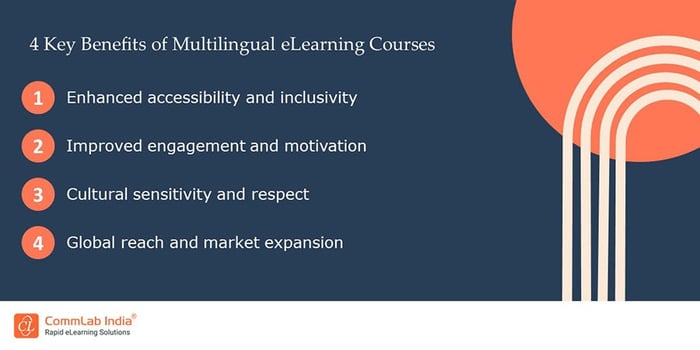How to Design Multilingual eLearning Courses for Diverse Teams
Training your global workforce is no more a challenge. Read on for design tips to create impactful multilingual eLearning courses for diverse teams.

In today's globalized business landscape, organizations are embracing diversity like never before. As teams become more multicultural and geographically dispersed, the need for effective multilingual eLearning experiences has become paramount. Multilingual eLearning courses emerge as a powerful solution to bridge language barriers and cater to diverse teams effectively. In this blog, we will delve into the essential aspects of designing and implementing multilingual eLearning courses tailored for diverse teams within corporate environments. We'll explore the compelling reasons behind the need for multilingual eLearning, uncover its myriad benefits, and uncover the best practices for crafting engaging and effective content that resonates across languages and cultures and caters to linguistic diversity within your workforce.
Designing Multilingual eLearning Courses for Diverse Teams?
Follow these tips:
- Understand Your Audience
- Maintain Consistency
- Utilize Professional Translation Services
- Adapt Content for Cultural Relevance
- Provide Language Support
Multilingual eLearning Courses — Why is There a Need?
In a corporate setting, where teams are often scattered across different geographical locations and cultural backgrounds, traditional training methods may fall short of effectively engaging every member. Multilingual eLearning courses address this challenge by offering training materials in multiple languages, thereby ensuring that every team member can access and comprehend the content irrespective of their language proficiency. Also, when the desired content is delivered in the native language of the learner, the learning is meaningful as it resonates with learners better.
→ Download eBook: Power of AI in eLearning Translations
What are the Key Benefits of Multilingual eLearning Courses?
Designing multilingual eLearning courses for diverse teams offers a range of benefits that can significantly impact an organization's learning and development strategy. Let's delve into five key advantages in detail:

1. Enhanced Accessibility and Inclusivity
In a diverse workforce where individuals may have varying levels of language proficiency, multilingual courses ensure that everyone has equal access to training materials, regardless of their language abilities. Increased accessibility to training materials can have a direct impact on performance and skill development within the organization. When employees have access to learning resources in their preferred language, they are more likely to engage with the content actively and take ownership of their learning journey. This, in turn, can lead to greater skill acquisition and professional growth, benefiting both the individual and the organization.
Crafting multilingual eLearning courses promotes inclusivity and ensures that all employees have the opportunity to participate in training programs. This not only enhances employee morale and satisfaction but also contributes to a more cohesive and collaborative work environment.
2. Improved Engagement and Motivation
When learners can access course content in their preferred language, they are more likely to feel comfortable and confident engaging with the content. This comfort level can lead to increased participation and interaction with the course material, ultimately resulting in better learning outcomes. When concepts are presented in a familiar language, learners can more easily grasp complex ideas, follow instructions, and absorb information effectively. This can lead to a deeper understanding of the subject matter and better retention of key concepts over time.
By catering to the linguistic needs of employees, organizations demonstrate their commitment to supporting individual learning preferences and creating an environment conducive to effective learning. This, in turn, fosters a culture of continuous learning and development within the workforce, ultimately contributing to improved performance and productivity.
3. Cultural Sensitivity and Respect
Offering content in multiple languages is not only a practical necessity but also a demonstration of cultural sensitivity and respect towards a diverse workforce. By acknowledging and accommodating linguistic diversity within the organization, organizations send a powerful message that they value and respect the cultural backgrounds of their employees.
Cultural sensitivity in training materials goes beyond just language translation. It involves adapting content to reflect cultural nuances, customs, and values that may impact the learning experience. This ensures that training programs resonate with employees from different cultural backgrounds and promote a sense of inclusivity and belonging within the organization. It also helps create a positive and inclusive work environment where all employees feel valued and respected, ultimately contributing to higher levels of employee satisfaction, engagement, and retention.
4. Global Reach and Market Expansion
In today's interconnected world, organizations are increasingly operating on a global scale, with teams spread across different countries across the globe. Multilingual eLearning courses enable organizations to expand their reach globally, tapping into new markets and opportunities while ensuring consistent training across regions.
Multilingual eLearning courses can be a strategic tool for international expansion and market penetration. By providing training materials in the local languages of target markets, organizations can better position themselves to attract and retain customers, partners, and employees in those regions. This can ultimately lead to increased market share, revenue growth, and competitive advantage on a global scale.
Multilingual eLearning Courses for Diverse Teams — 5 Best Practices While Crafting Content
1. Understand Your Audience
Before embarking on the development of multilingual eLearning courses, it's paramount to conduct thorough research to grasp the linguistic and cultural diversity present within your organization. This entails identifying the languages spoken by your workforce and assessing their proficiency levels in each language. Understanding these factors allows you to tailor the course content to suit the specific needs and preferences of your audience.
For instance, if your workforce comprises individuals from various linguistic backgrounds with varying degrees of proficiency in a common language, you may need to prioritize certain languages for translation or provide additional language support resources for those with lower proficiency levels. By taking the time to understand your audience's linguistic diversity, you can ensure that your multilingual eLearning courses effectively cater to the needs of all learners, regardless of their language abilities.
2. Maintain Consistency
Consistency is a cornerstone of effective communication, especially when it comes to translating eLearning courses into multiple languages. It's essential to ensure that terminology, style, and tone remain consistent across all language versions to avoid confusion and maintain the integrity of the content.
Inconsistencies in language use can lead to misunderstandings and detract from the overall learning experience. Therefore, establishing clear guidelines for translation and maintaining open communication with translators and content creators is crucial. By adhering to a consistent approach to translation, you can ensure that your multilingual eLearning courses deliver a cohesive and seamless learning experience to all learners, regardless of the language they are using.
3. Utilize Professional Translation Services
Engaging your in-house team in crafting multilingual eLearning courses might seem feasible and cost-effective, but trust me it can be a daunting task, despite having a team proficient in multiple languages. It is not only time-consuming but also the output might not be satisfactory as mere knowledge of the language is not enough to create multilingual courses. Investing in professional translation services is paramount when you want to design multilingual eLearning. While machine translation tools may offer a quick and cost-effective solution, they often fall short of capturing the nuances of language effectively.

Professional translators bring expertise and linguistic fluency to the table, ensuring accurate and high-quality translations that resonate with native speakers. They can also help adapt content to suit cultural preferences and linguistic conventions, enhancing the overall effectiveness of the eLearning courses. Seasoned translators also have prowess in leveraging translation tools and have in-depth knowledge of the guidelines and industry best practices to craft hassle-free multilingual eLearning courses. By partnering with professional translation services, you can rest assured that your multilingual eLearning courses will be of the highest quality, thereby maximizing their impact and effectiveness among diverse learners.
4. Adapt Content for Cultural Relevance
Cultural nuances play a significant role in communication, and this holds true for eLearning courses as well. When translating content into multiple languages, it's essential to adapt the material to ensure cultural relevance and sensitivity. This involves more than just translating words; it requires understanding the cultural context in which the content will be consumed and adjusting accordingly.
For example, certain references or examples that may be relevant in one culture may not resonate with individuals from other cultural backgrounds. By taking the time to adapt the content of eLearning courses to reflect the cultural diversity of your audience, you can ensure that the material is not only understood but also appreciated and valued. This fosters a sense of inclusivity and respect within the organization, ultimately contributing to a more positive and engaging learning experience for all learners.
5. Provide Language Support
Offering language support tools is essential for facilitating learning and addressing any language-related challenges that learners may encounter. This can include providing glossaries, translations of key terms, and language-specific forums or discussion boards where learners can seek clarification and assistance. Language support tools not only help learners navigate language barriers but also empower them to take ownership of their learning journey. By providing resources that cater to their linguistic needs, you can foster a sense of confidence and independence among learners, ultimately enhancing their overall learning experience.
Additionally, language support tools can serve as valuable resources for promoting cross-cultural understanding and collaboration within the organization. By encouraging learners to engage with content in different languages and exchange ideas with colleagues from diverse linguistic backgrounds, you can create a more inclusive and dynamic learning environment that benefits learners as well as the organization.
All set to design multilingual eLearning courses? Well, hosting them on your learning management system is the next step. Watch this video to get insights on how multilingual wrapper can make it a breeze.
Break Linguistic Barriers and Enhance Global Learning
In an increasingly diverse corporate environment, designing multilingual eLearning courses is not just a matter of convenience but a strategic necessity. By embracing multilingualism in training initiatives, you can foster inclusivity, improve engagement, and empower diverse teams to thrive. Implementing the best practices outlined above will enable you to craft effective multilingual eLearning courses that cater to the needs of your diverse workforce, ultimately driving business success in a globalized world.
All set to embark on your journey to offer inclusive and immersive learning experiences to your global workforce? Well, here’s an eBook to make your journey exciting — The Future Speaks Every Language: Power of AI in eLearning Translations. Get insights to foster inclusive learning with AI-powered eLearning Translations. Click to get your copy!





